When you type out “Tarantulas” to learn more about them, you may discover that they are divided into two categories: Old World and New World. The classification might seem like you’re referring to ancient and new-generation spiders, but this isn’t the case. The Old World vs. New World tarantulas classification is based on the geographical location of these spiders. This article discusses the differences between Old World tarantulas and New World tarantulas and presents a list of all of them.
Key Differences Between Old World and New World Tarantulas

In addition to the location differences, Old World and New World tarantulas also vary in terms of their physical features and temperament. Generally, Old World tarantulas are more aggressive than New World species, which is why many believe that New World tarantulas are better pets than the Old World counterparts. Before we get into the list of the different species under each classification, here are the differences between the Old and New World tarantulas in terms of different features.
Geographic Location
The Old World and New World tarantula classification is based on the specific native origin of these spider species. Generally, continents were well-known before Christopher Columbus discovered the Americas. These are landmasses in the eastern hemisphere which includes Europe, Africa, and Asia. Tarantulas whose native origin is from any of these continents are referred to as the Old World species. Europeans referred to the continents of South, Central, and North America as the New World. Therefore, tarantulas from countries on these continents are called New World tarantulas.
Urticating Hairs
One of the most obvious physical differences between the Old and New World tarantulas is the presence of urticating hairs. Basically, New World tarantulas are hairier than Old World tarantulas. The urticating hair in New World tarantulas covers their upper back and has barbs that can puncture predators, acting as a defense mechanism. The hair can also irritate the skin and mucous membranes, warding off predators. This urticating hair is also present in Old World tarantulas. However, it’s significantly less pronounced, and they don’t use their hair for defense the same way the New World species do.
Agility and Speed
One advantage Old World species have over New World tarantulas is their speed and agility. Their first line of defense against predators is to outrun them, and they are one of the fastest spider species alive. They are so fast that you might hardly notice them running away. New World tarantulas are not as agile, which is another factor that makes it easier to keep them as pets.
If you want to care for a tarantula, you will require more space for an Old World tarantula so that it can run around freely. New World tarantulas are docile. They are more content in a small, enclosed space.
Aggression
Old World tarantulas’ strength and agility also show in their behaviors. They are more aggressive than New World tarantulas and like to defend their territory. They do not do well being handled, and they will likely attack before they run away. Although all tarantulas are venomous, Old World tarantulas have a more painful and venomous bite. The bite is not fatal, however, it can cause serious pain, muscle spasms, lightheadedness, and cramps.
Common Old World Tarantula Species
Old World tarantulas don’t have urticating hairs, which is the major defensive mechanism for most tarantula species. However, they’re agile and aggressive. This group of spiders can deliver a very painful bite when threatened. Examples of Old World tarantula species include:
Poecilotheria regalis (Indian Ornamental Tarantula)

Even though they are aggressive and territorial, they sometimes
live together
with similar species.
©fivespots/Shutterstock.com
As the common name suggests, the Indian ornamental tarantula is native to India. It is an arboreal tarantula typically found in tall trees where they create asymmetric funnel webs. They prey on flying insects by paralyzing them in flight. Even though they are aggressive and territorial, they sometimes live together with similar species. The bite is not fatal; however, it is venomous and causes excruciating pain. People like to keep this tarantula as a pet due to its peculiar appearance. They have white and black bodies with yellow spots on their legs.
Birupes simoroxigorum (Neon Blue Leg Tarantula)
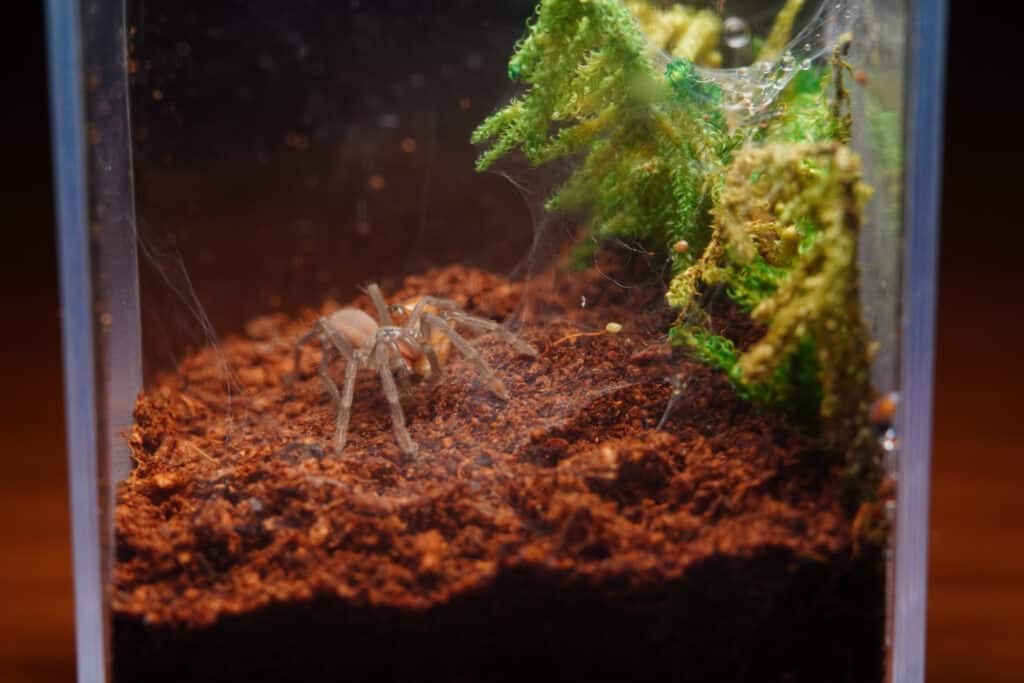
The Neon Blue Leg Tarantula is peaceful, making it a great choice for beginners that want to keep spiders.
©Lemonade Serenade/Shutterstock.com
The name “Neon Blue Leg” is a reference to their unique coloration and the striking appearance of this tarantula, which is also their primary attractive feature. Some people consider this spider the most beautiful tarantula in the world. Birupes simoroxigorum are shy, solitary arachnids. The spider spends most of its days in burrows. The Neon Blue Leg Tarantula is peaceful, making it a great choice for beginners that want to keep spiders.
Pelinobius muticus (King Baboon Spider)

They are larger than the typical Old World
tarantulas species making them harder to care for and breed
.
©Federico.Crovetto/Shutterstock.com
It is the only species in this east African tarantula genus (Pelinobus). It is a terrestrial spider found in grasslands and shrublands in Kenya, Tanzania, and some other parts of East Africa. Pelinobius muticus has a striking orange or copper-brown color. They are larger than the typical Old World tarantulas species making them harder to care for and breed. They feed on other spiders, cockroaches, and beetles, and they detect the prey’s movement by forming a silk web at the entrance of their burrows.
Poecilotheria ornata (Fringed Ornamental Spider)
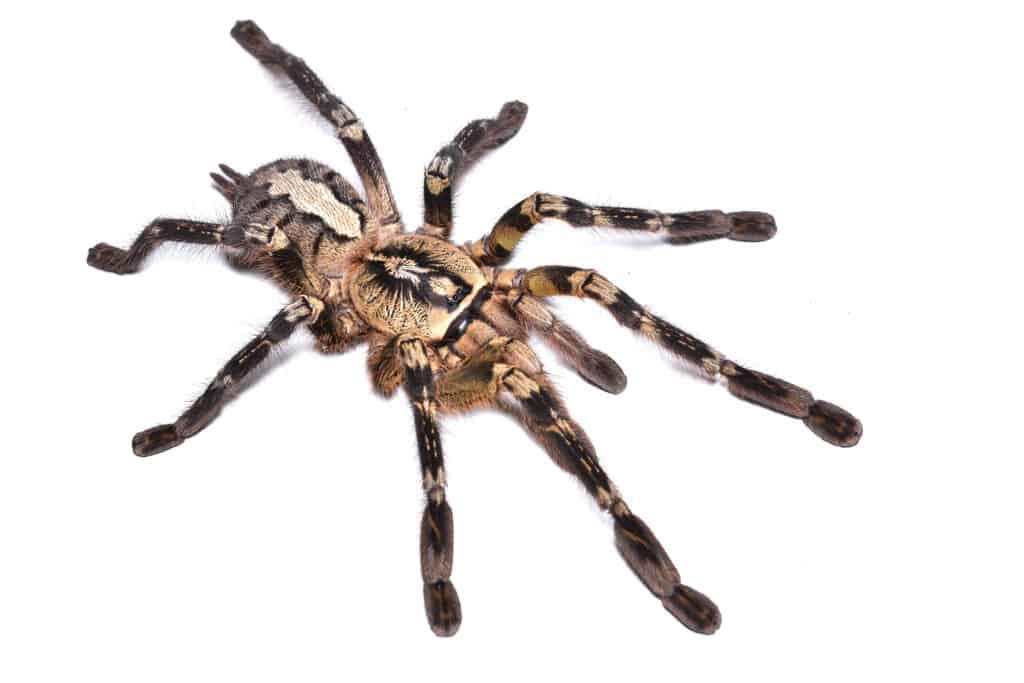
Ornate
tiger
spider is another name for this species and a reference to their leg color and stripes, which is similar to that of tigers.
©Tobias Hauke/Shutterstock.com
They are arboreal tarantulas found in Sri Lanka. They are the second largest of the Old World tarantulas. In addition to their massive size, they deliver painful venomous bites. Ornate tiger spider is another name for this species and a reference to their leg color and stripes, which is similar to that of tigers. The colorful pattern and beautiful stripes make them great as display pets.
Poecilotheria metallica (Gooty Sapphire Tarantula)
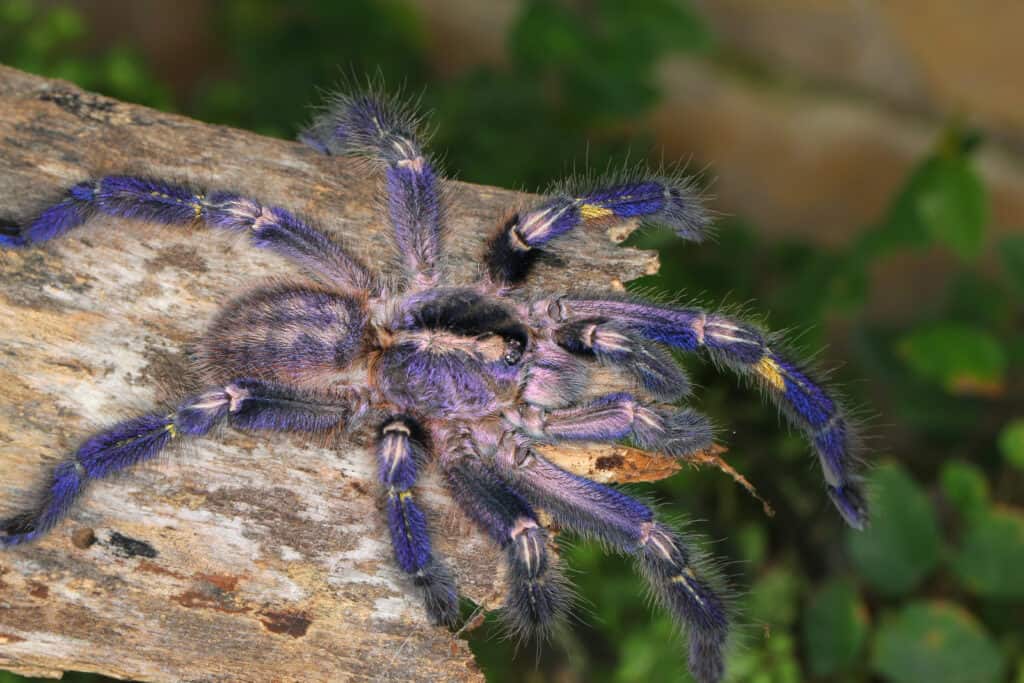
Even though their beauty makes them wonderful display spiders, they are aggressive and venomous, which makes raising them challenging.
©Pong Wira/Shutterstock.com
This is one of the most stunning tarantula species in the world, with its metallic blue color spotted with yellow and black. It is an arboreal tarantula native to India. Even though their beauty makes them wonderful display spiders, they are aggressive and venomous, which makes raising them challenging.
Pterinochilus murinus (Orange Baboon Tarantula)
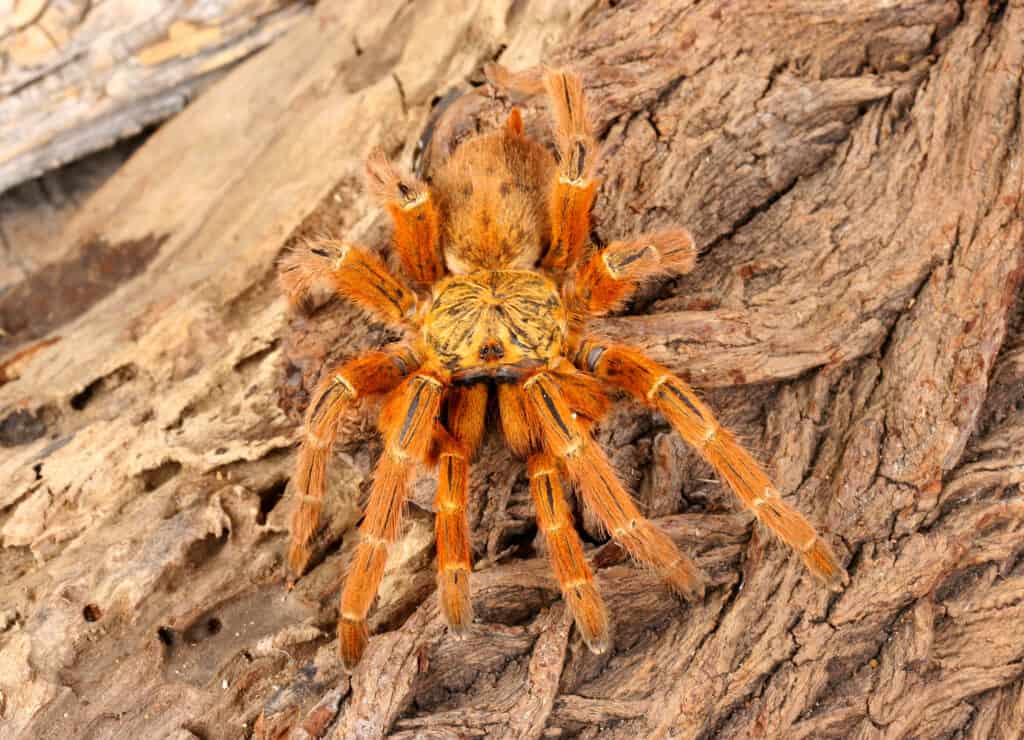
They are terrestrial spiders that show some arboreal tendencies.
©Audrey Snider-Bell/Shutterstock.com
Pterinochilus murinus belongs to the baboon spider genus and is one of the most beautiful members of the group. It comes in a rare range of colors, but the orange coloration is more prominent. They are terrestrial spiders that show some arboreal tendencies. They are very fast, super aggressive, and defensive. So, they are only recommended for people skilled in tarantula handling.
Haplopelma minax (Thailand Black Tarantula)

Like many Old World tarantulas, they are fast and aggressive.
©Pavaphon Supanantananont/Shutterstock.com
This is a type of jet-black tarantula found in Thailand. It is a terrestrial, burrowing tarantula that spends most of its time in caves. Like many Old World tarantulas, they are fast and aggressive. They have eight eyes but have terrible vision. To catch prey, this spider spins web near its abode and can sense the presence of the prey when the silk vibrates.
Chilobrachys fimbriatus (Indian Violet Tarantula)
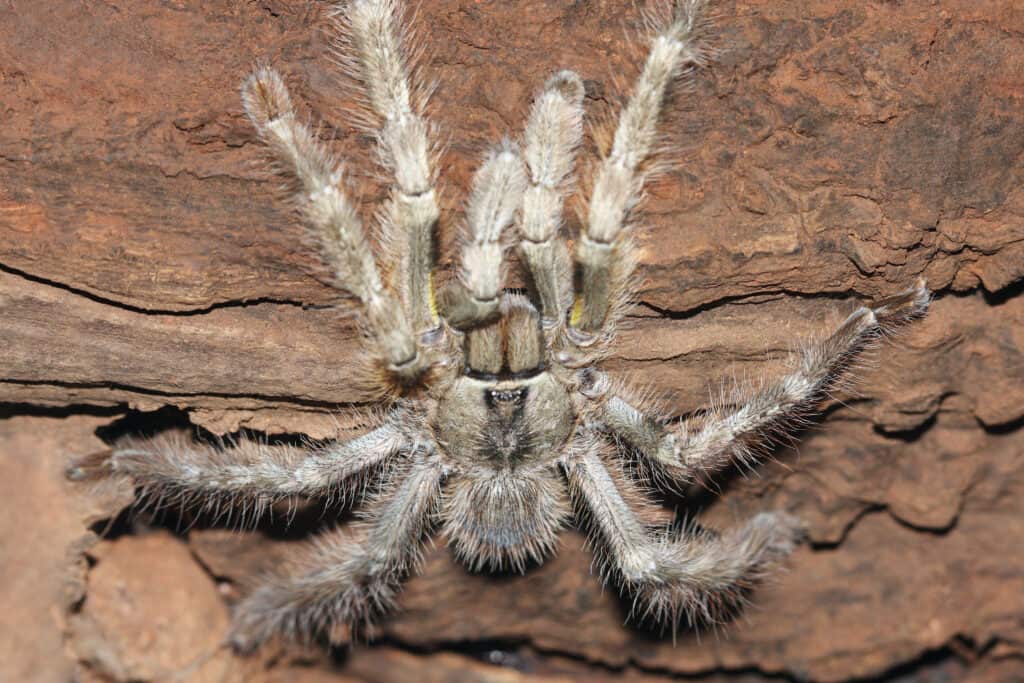
Indian Violet Tarantulas are heavy webbers known to create interesting structures with their web.
©RealityImages/Shutterstock.com
These are burrowing native Indian tarantulas with a peculiar violet color. They are quite common among intermediate keepers because of their beauty. Chilobrachys fimbriatus is moderately defensive and has potent venom. They are heavy webbers known to create interesting structures with their web.
Chilobrachys sp. (Electric Blue Tarantula)
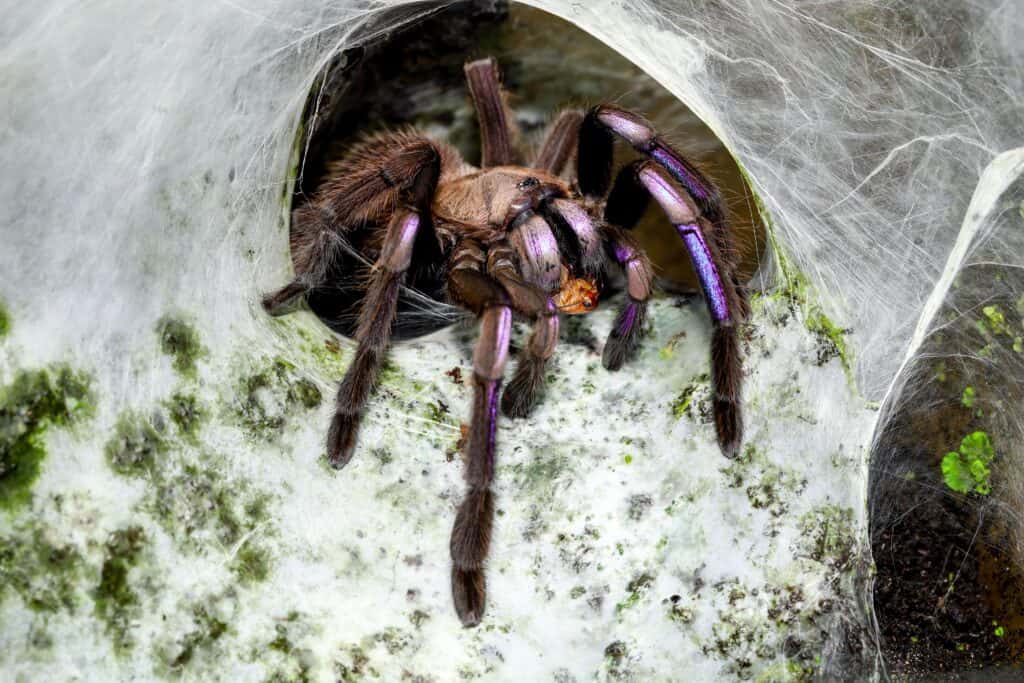
Electric blue tarantulas are terrestrial spiders that spend most of their time in burrows.
©monster_code/Shutterstock.com
As the name implies, this spider has a brilliant blue color. It is iridescent, which means the blue color glows in the dark. Electric blue tarantulas are terrestrial spiders that spend most of their time in burrows. They are heavy webbers that spin silk near their burrow to catch prey.
Haploclastus devamatha (Indian Rainbow Tarantula)

Beyond their impressive appearance, the rainbow tarantula does not make a great pet because of its aggressive nature and painful bite.
©Lemonade Serenade/Shutterstock.com
The name of this tarantula might be a bit misleading because it does not have all the rainbow colors. They do showcase different colors, which makes them a very attractive species. They are also one of the most expensive tarantulas, and that’s likely due to their impressive colors. Beyond their impressive appearance, the rainbow tarantula does not make a great pet because of its aggressive nature and painful bite.
Common New World Tarantulas
New World tarantulas are more commonly kept as pets because of their mild temperament and docile nature. Beginners are often advised to start their journey as tarantula hobbyists with one of these common New World tarantulas. Of course, this rule has a few exceptions since some New World species can be aggressive too.
Ephebopus cyanognathus (Blue Fang Tarantula)
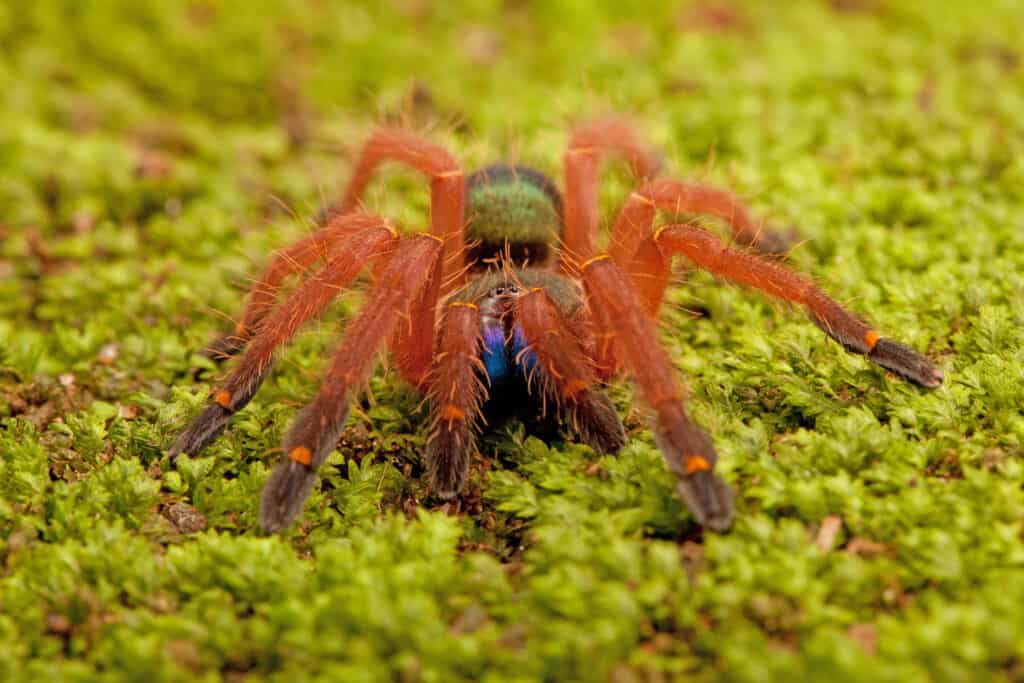
Blue Fang Skeleton Tarantula (Ephebopus cyanognathus) on green moss
©Linn Currie/Shutterstock.com
The name “cyanognathus” means “blue jaw” (cyano means blue, and jaw is gnathus). They are semi-arboreal, burrowing spiders. Their blue fangs are their most striking feature. The fangs are blue in females but purple in males. They are not seen quite often because of their burrowing nature. They also don’t make great pets because of their defensive and skittish attitude.
Chromatopelma cyaneopubescens (Greenbottle Blue Tarantula)
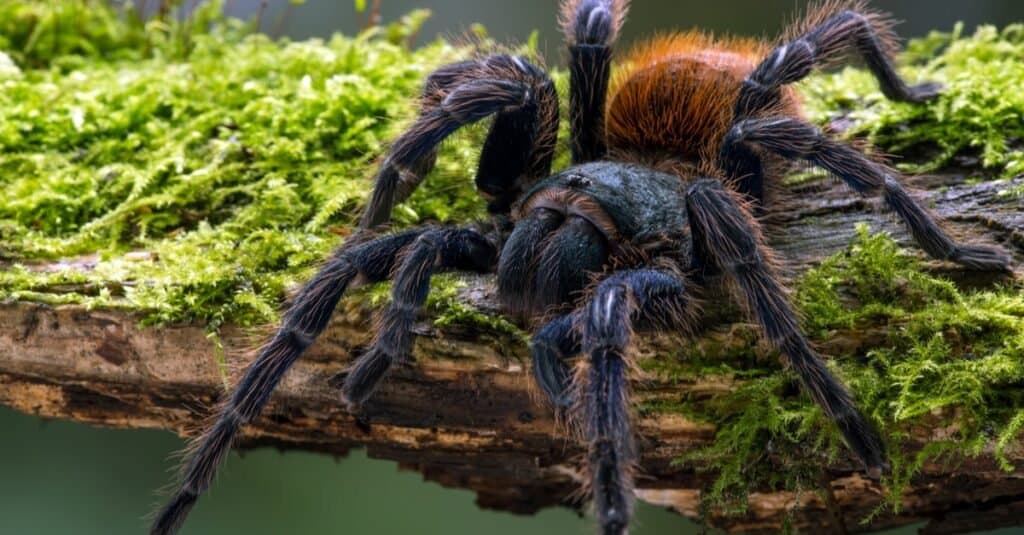
The greenbottle blue tarantula is a peculiar spider commonly kept for its display quality.
©davemhuntphotography/Shutterstock.com
Their name refers to their blue-green carapace and metallic blue legs. They belong to a genus of South American Tarantulas native to the Paraguana Peninsula. The greenbottle blue tarantula is a peculiar spider commonly kept for its display quality. They are quite docile and are not very defensive. They rarely bite, and when they do, the bites are not as painful as many other tarantula breeds, making them very common among hobbyists.
Caribena versicolor (Antilles Pink Toe Tarantula)
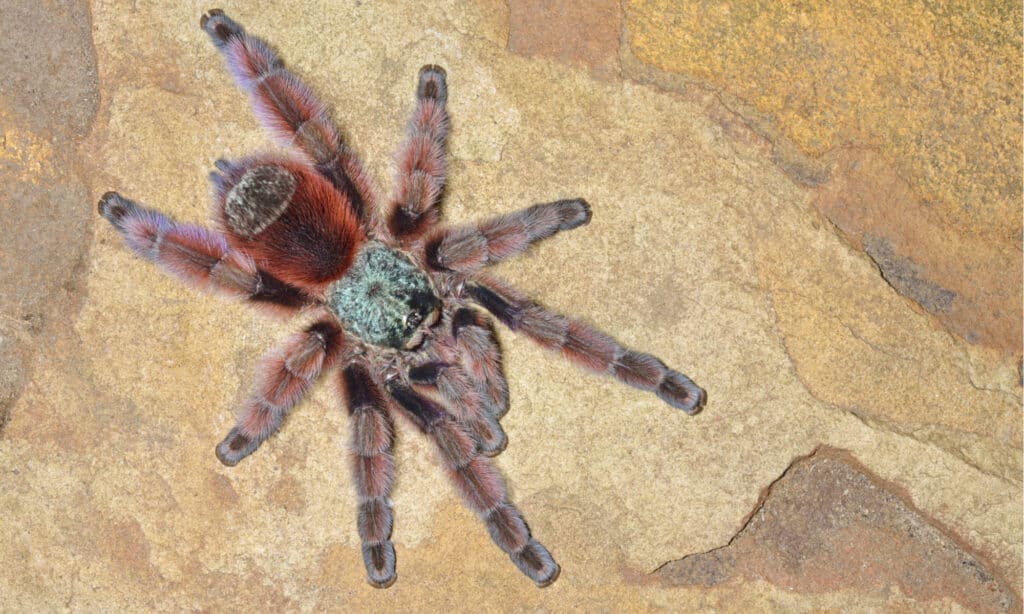
Their native home is part of the Lesser Antilles (hence their name).
©Dean Pennala/Shutterstock.com
Caribena Versicolor is a captivating tarantula found in Martinique in the Caribbean islands. Their native home is part of the Lesser Antilles (hence their name). They are bright blue tarantulas with red abdomens, green carapace, and green legs with pink tarsi. They are also suitable to display tarantulas because of their colorful body and friendly, docile behavior. This spider is good for beginners because they are calm and easy to care for.
Avicularia avicularia (Pink Toe Tarantula)

The pink toe is an aggressive tarantula known to
ambush prey and hunt
actively.
©Gerry Bishop/Shutterstock.com
The pink toe tarantula is also referred to as Guyana or South American pink toe tarantulas due to the pink coloration on the tips of their legs. They are dark-colored, arboreal tarantulas found in Costa Rica, Southern Caribbean, Brazil, and South America. The pink toe is an aggressive tarantula known to ambush prey and hunt actively.
Brachypelma hamorii (Mexican Red Knee Tarantula)
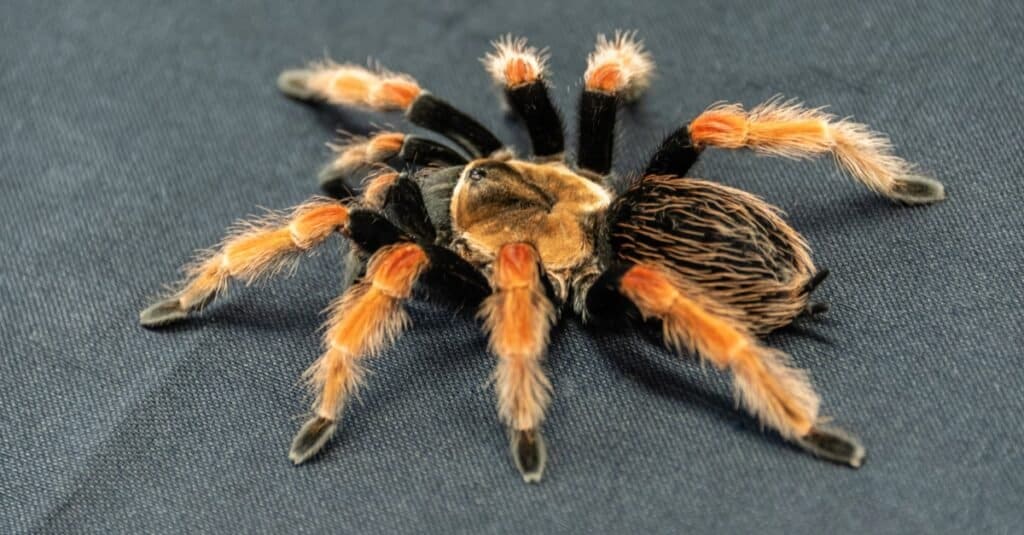
The Mexican red knee is famous among beginners because of its beautiful appearance and highly docile behavior.
©James McKay/Shutterstock.com
This tarantula species is native to Mexico and is quite similar to the Brachypelma smithi in appearance. The Mexican red knee is famous among beginners because of its beautiful appearance and highly docile behavior. Despite their large fangs, they rarely get aggressive unless in extreme danger. They are ground-dwelling tarantulas that spend time in their burrows.
Ephebopus murinus (Skeleton Tarantula)
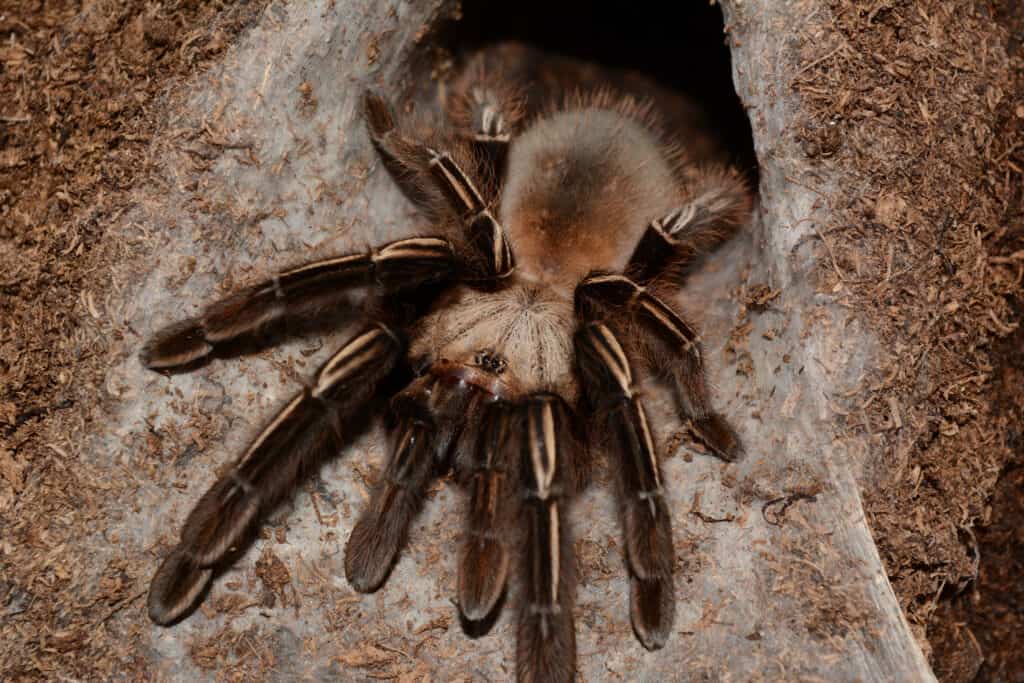
Unlike other members of their family that tend to live on trees, skeleton tarantulas are ground-dwelling.
©xtotha/Shutterstock.com
These are fossorial tarantulas commonly found in rainforests. Unlike other members of their family that tend to live on trees, skeleton tarantulas are ground-dwelling. They may even burrow into the subsoil sometimes. Their unique common name is due to the skeleton-like pattern on their legs. Their unique look is their main attraction. Otherwise, they wouldn’t make great pets since they tend to be more defensive than the typical New World tarantulas.
Hapalopus sp. Colombia (Pumpkin Patch Tarantula)
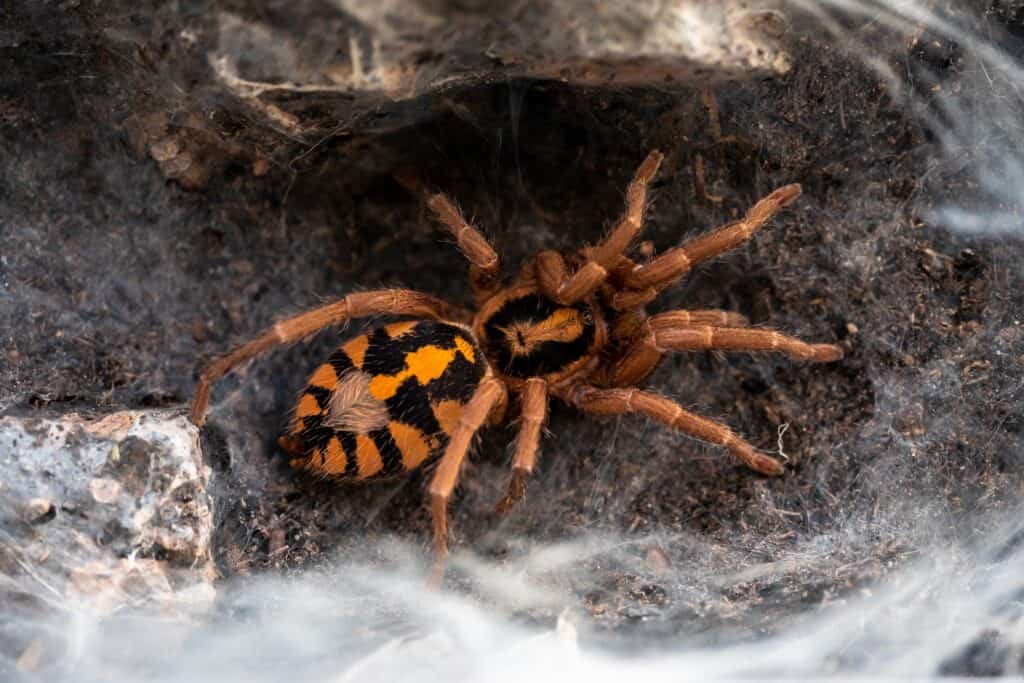
This
spider is known for its striking black
and orange patterns, which is why they are highly sought-after.
©tempisch/Shutterstock.com
They are terrestrial tarantulas native to Colombia. Although they’re mostly dwarf tarantulas, they come in bigger varieties too. This spider is known for its striking black and orange patterns, which is why they are highly sought-after. They are mildly aggressive, using their urticating hair for defense. Their venoms are mild and not dangerous to humans.
Aphonopelma chalcodes (Arizona Blonde)
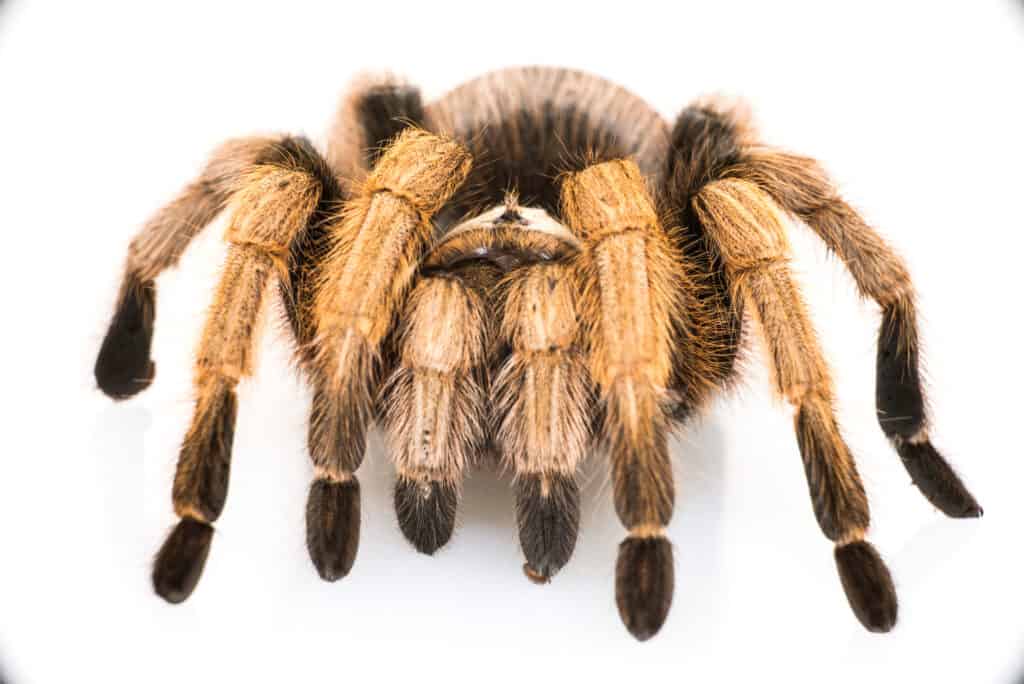
Its name is due to its blond urticating hair, which is common in females.
©bloomphoto/Shutterstock.com
This terrestrial tarantula is native to some parts of Mexico and the United States (Arizona). Its name is due to its blond urticating hair, which is common in females. The males have darker hair. Its unique appearance and docile behavior make them suitable for beginner hobbyists.
Theaphosa blondi (Goliath Birdeater Tarantula)
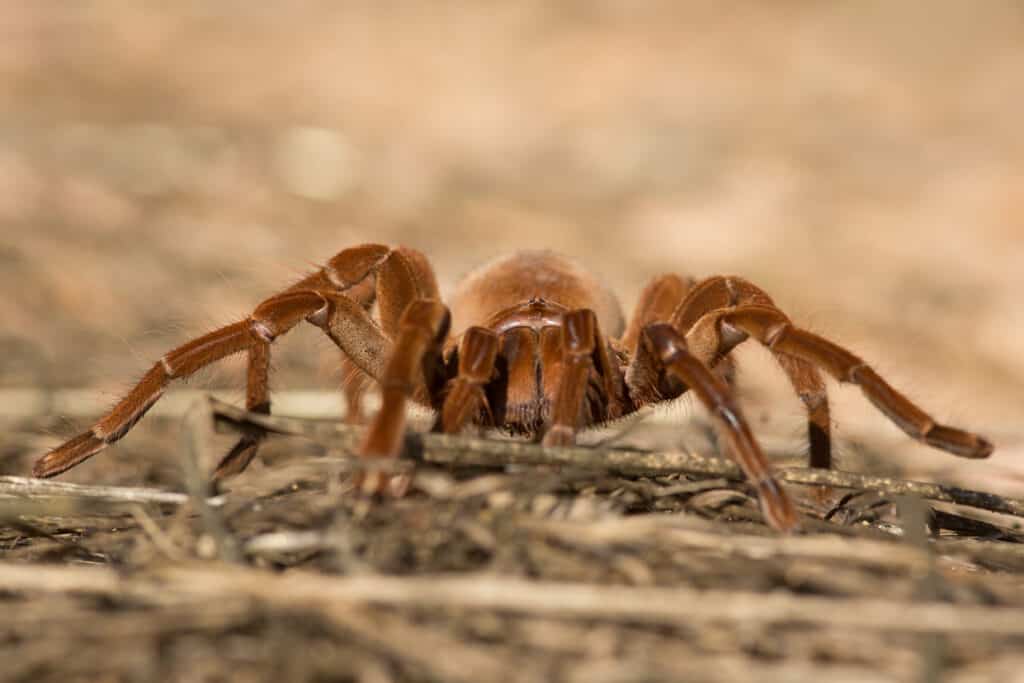
Found in northern South America, the Goliath birdeater is the
largest spider
in the world by mass and size.
©Milan Zygmunt/Shutterstock.com
Their name is fitting as this spider is truly massive. In fact, they’re the world’s heaviest spiders. They are burrowers and spin webs to catch their prey, including birds, lizards, and other small mammals. This giant spider is fast, aggressive, and highly defensive. However, their venoms are not very potent. They are also more suitable for experienced keepers.
Grammostola pulchripes (Chaco Golden Knee Tarantula)

The Chaco Golden Knee tarantula is a burrower at the early stages of its life, and as they age, they find a suitable permanent hideout.
©NATTHAWAT101/Shutterstock.com
These terrestrial tarantulas are found in grasslands in Argentina and Paraguay. They are also giant tarantulas. They are, however, quite gentle, like typical New World tarantulas. The Chaco Golden Knee tarantula is a burrower at the early stages of its life, and as they age, they find a suitable permanent hideout. They are suitable for beginners who want to start with a giant tarantula.
Conclusion
The main distinction between New World and Old World tarantulas is their continent of origin, appearance, and general temperament. Beginners are often advised to go for New World varieties because they’re more docile and deliver a less painful bite. However, as you get more experienced with keeping spiders, you may be able to go for Old World tarantulas because they’re quite a delight to raise as well.
Bonus: How Do You Keep Spiders Out of Your House?

Tea tree oil is an excellent alternative to commercial pesticides, as the scent repels spiders.
©AmyLv/Shutterstock.com
It’s true that there is a segment of the population that enjoys keeping exotic spiders like tarantulas as pets. But most of us would not like running across a spider stranger in our house–especially the poisonous kind! What are some ways to keep these creepy crawlies out of your home?
As spiders penetrate structures through holes and cracks, you can check for possible entryways with a flashlight. If the light gets through from the inside to the outside, you should fill that hole or crevice with an appropriate product.
Keeping your yard free of debris and overgrown vegetation helps cut down on areas spiders would gravitate to. Caulking doors and windows is also a good strategy to keep them out.
Spiders hate certain scents, so scented essential oils can help deter them like peppermint, tea-tree, lavender, and rose. You can add 15-20 drops of a particular oil in a water bottle mixed with water and spritz it around your house. They also hate the smell of cinnamon and vinegar, so these scents can be used similarly.
Rubbing lemon or orange peels on the baseboards along your walls, on window sills, and on other surfaces can also repel spiders, who dislike citrus smells. Furniture polish and cleaning products with lemon scent can also help.
Regular cleaning inside your home, especially in areas that are dark or less frequented, is necessary to keep spiders from setting up residence. It’s also important to keep an eye on fruit bowls, as they can attract spiders.
The photo featured at the top of this post is © Lemonade Serenade/Shutterstock.com
Sources
- ThePetFAQ, Available here: https://thepetfaq.com/new-world-tarantulas/
- ThePetFAQ, Available here: https://thepetfaq.com/old-world-tarantulas/
Thank you for reading! Have some feedback for us? Contact the AZ Animals editorial team.






